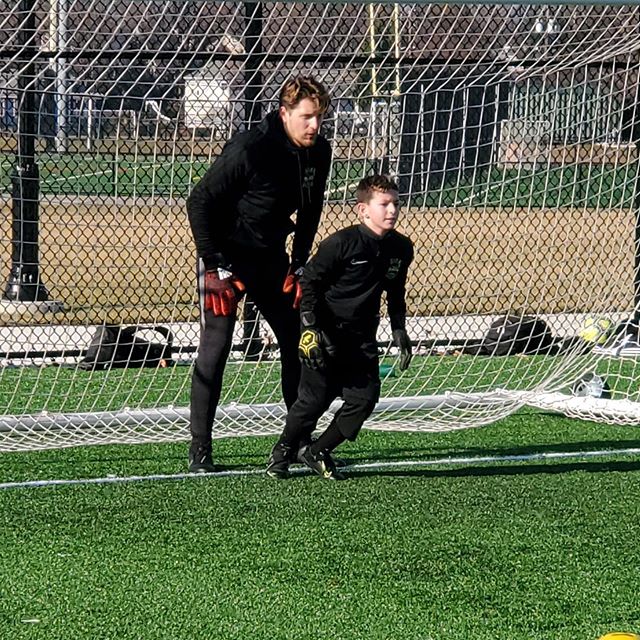Where do we stand on the field? Coach says play higher but you do not want to play too far from your goal? Are we the 11th field player or can we just stay in our box?
Good positioning is essential for a timely intervention and it is appropriate to say that the goalkeeper must be in the right place at the right time. The position that the goalkeeper must assume in and out of goal depends on several factors and in particular on the distance and position of the ball. In possession or in recovery, the goalkeeper’s position essentially is always adjusting and moving to best suit the play.
How high or low is the Goalkeeper’s position?
Defensively, the greater the distance of the ball from the goal, the higher the position of the goalkeeper. So if the ball is in the opponent’s half, the goalkeeper generally stays beyond the penalty area. As the distance to the ball is reduced, the goalkeeper retreats until he/she is positioned just a few yards in front of the goal line when the opposing team is in possession and an attacking threat. The goalkeeper can stand as far out of the goal as needed as long as the goal is not threatened by a shot. We want to close down the space behind the defense while simultaneously covering the frame from any distant strikes.
In possession of the ball, the goalkeeper needs to provide a supporting passing line, preferably a passing line that is away from the frame of the goal – just in case we miss-control the back pass. When we have a corner kick to take, the ball is as far as possible from our goal, we can comfortably stand halfway between the goal line and the half field point because there is no threat to our net.
The goalkeeper doesn’t often stand exactly on the goal line, he/she always tries to stand at least a few steps in front. We do stand on the goalline when calling “away” on a cross or during a penalty, outside of those two scenarios we want to be at least a step off the goal line.
Angles
When the play is developing in proximity to the goal and the opposing team is in possession, the possibility of facing a direct shot increases for the goalkeeper. That’s when the goalkeeper may have to adjust also laterally in his/her starting position in order to be positioned at the correct angle. What is this angle that our coaches talk about?
The centerline of the triangle
Conventionally the position of the goalkeeper is the centerline (bisector) of a triangle whose base are the two posts and the ball represents the vertex. The depth position of the goalkeeper (in terms of depth) depends on the distance of the ball from the goal. The lateral adjustment depends on the angle of the ball to the center of the goal line.
The goalkeeper must always be more or less on the centerline of the triangle formed by the lines that join the position of the ball and the two goal posts. See the diagram below.
As the goalkeeper moves to constantly adjust the angle to the ball, it is important to maintain a balanced body shape. The faster the goalkeeper can adjust to the angle the more likely the goalkeeper will have stability when the shot does actually occur. These movements might be lateral, vertical or even diagonal in certain circumstances.
Professional Examples:
Empoli-Cremonese 2-0 | Three Golden Points for Empoli: Goals & Highlights | Serie A 2022/23 min 1:30 sec – Save by Goalkeeper Vicario, Empoli F.C. – The goalkeeper adjusts his position in accordance to the angle and he does so by use of one cross step and then a lightning fast hop lateral adjustment to get set.
Verona-Spezia 1-2 | Nzola double fires Spezia to away win: Goals & Highlights | Serie A 2022/23 min 1:17 sec – Save by Goalkeeper Montipo’, Hellas Verona, – The goalkeeper is dropping his position as the opponent is rushing towards the box. He adjusts his position by one lateral step movement towards the near post as the striker decentralizes himself in pursuit of space. The goalkeeper does a very good job at keeping a stable, coordinated stance throughout and he is ready when the shot is taken.
How to work on it :
Creating drills where the ball is being moved around and shot from various angles. Have the Goalkeeper adjust the position as the ball is moving and getting set with the correct positioning and timing for the shot.
Watching footage of games to assess if positioning is correct is always beneficial to learning how to improve.
Examples:
- If the ball is on the other team’s half by the corner kick, the goalkeeper will stand outside his/her box if not further up the field.
- If the ball is in possession of the opposing team on the midfield line whether centrally or on the flanks, the goalkeeper stands between 6yrd line and penalty spot. There is no need to shift right or left in case the ball is on either flank because the distance is still big and the ball will probably be served towards the middle. If there is pressure on the ball and there are a lot of attacking runners then maybe the goalkeeper can be higher in anticipation of the through ball knowing that the pressure on the ball won’t allow for a long chip.
- If the opposing team is attacking and is playing the ball at the edge of the box but not in a central position, the goalkeeper adjusts his/her position towards that side and will usually stand a couple yards off the goal line.
- When the ball is very lateral and close to the end line but still outside the 18 yard box, the goalkeeper doesn’t stand too close to the near post now because the possibility of a shot is very low while chances of a cross are very high.


